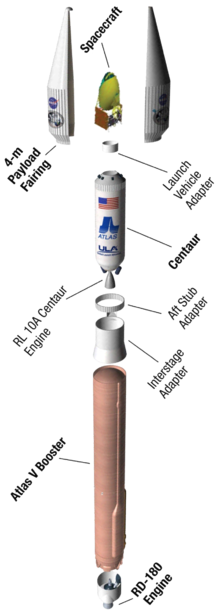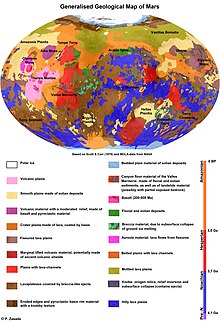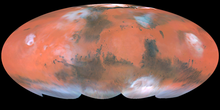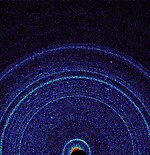https://en.wikipedia.org/wiki/Atlas_V
Atlas V is the fifth major version in the Atlas rocket family. It is an expendable launch system originally designed by Lockheed Martin, now being operated by United Launch Alliance (ULA), a joint venture between Lockheed and Boeing.
Each Atlas V rocket consists of two main stages. The first stage is powered by a Russian RD-180 engine manufactured by RD Amross and burning kerosene and liquid oxygen. The Centaur upper stage is powered by one or two US RL10 engine(s) manufactured by Aerojet Rocketdyne and burning liquid hydrogen and liquid oxygen. AJ-60A strap-on solid rocket boosters (SRBs) are used in some configurations and will be replaced by GEM-63 SRBs in the near future. The standard payload fairings are 4 or 5 meters in diameter with various lengths.

Launch of an Atlas V 401 carrying the Lunar Reconnaissance Orbiter and LCROSS space probes on June 18, 2009
| |
| Function | EELV/medium-heavy launch vehicle |
|---|---|
| Manufacturer | United Launch Alliance |
| Country of origin | United States |
| Cost per launch | US$110 million in 2016 |
| Size | |
| Height | 58.3 m (191 ft) |
| Diameter | 3.81 m (12.5 ft) |
| Mass | 590,000 kg (1,300,000 lb) |
| Stages | 2 |
| Capacity | |
| Payload to LEO | 8,250–20,520 kg (18,190–45,240 lb) |
| Payload to GTO | 4,750–8,900 kg (10,470–19,620 lb) |
| Associated rockets | |
| Family | Atlas (rocket family) |
| Comparable | |
| Launch history | |
| Status | Active |
| Launch sites | Cape Canaveral SLC-41 Vandenberg SLC-3E |
| First flight | 21 August 2002 (Hot Bird 6) |
| Last flight | Active |
| Notable payloads | |
| Boosters – AJ-60A | |
| No. boosters | 0 to 5 |
| Length | 17.0 m (669 in) |
| Diameter | 1.6 m (62 in) |
| Gross mass | 46,697 kg (102,949 lb) |
| Propellant mass | 42,630 kg (93,980 lb) |
| Thrust | 1,688.4 kN (379,600 lbf) |
| Specific impulse | 279.3 s (2.739 km/s) |
| Burn time | 94 seconds |
| Fuel | HTPB |
| First stage – Atlas CCB | |
| Length | 32.46 m (106.5 ft) |
| Diameter | 3.81 m (12.5 ft) |
| Empty mass | 21,054 kg (46,416 lb) |
| Propellant mass | 284,089 kg (626,309 lb) |
| Engines | 1 RD-180 |
| Thrust | 3,827 kN (860,000 lbf) (SL) 4,152 kN (933,000 lbf) (vac) |
| Specific impulse | 311.3 s (3.053 km/s) (SL) 337.8 s (3.313 km/s) (vac) |
| Burn time | 253 seconds |
| Fuel | RP-1 / LOX |
| Second stage – Centaur | |
| Length | 12.68 m (41.6 ft) |
| Diameter | 3.05 m (10.0 ft) |
| Empty mass | 2,316 kg (5,106 lb) |
| Propellant mass | 20,830 kg (45,920 lb) |
| Engines | 1 RL10A or 1 RL10C |
| Thrust | 99.2 kN (22,300 lbf) (RL10A) |
| Specific impulse | 450.5 s (4.418 km/s) (RL10A-4-2) |
| Burn time | 842 seconds (RL10A-4-2) |
| Fuel | LH2 / LOX |
Atlas V is the fifth major version in the Atlas rocket family. It is an expendable launch system originally designed by Lockheed Martin, now being operated by United Launch Alliance (ULA), a joint venture between Lockheed and Boeing.
Each Atlas V rocket consists of two main stages. The first stage is powered by a Russian RD-180 engine manufactured by RD Amross and burning kerosene and liquid oxygen. The Centaur upper stage is powered by one or two US RL10 engine(s) manufactured by Aerojet Rocketdyne and burning liquid hydrogen and liquid oxygen. AJ-60A strap-on solid rocket boosters (SRBs) are used in some configurations and will be replaced by GEM-63 SRBs in the near future. The standard payload fairings are 4 or 5 meters in diameter with various lengths.
Vehicle description
The Atlas V was developed by Lockheed Martin Commercial Launch Services (LM CLS) as part of the US Air Force Evolved Expendable Launch Vehicle (EELV) program and made its inaugural flight on August 21, 2002. The vehicle operates out of Space Launch Complex 41 at Cape Canaveral Air Force Station and Space Launch Complex 3-E at Vandenberg Air Force Base.
LM CLS continued to market the Atlas V to commercial customers
worldwide until January 2018, when ULA assumed control of commercial
marketing and sales.
Atlas V first stage
The Atlas V first stage, the Common Core Booster (CCB), is 12.5 ft (3.8 m) in diameter and 106.6 ft (32.5 m) in length. It is powered by a single Russian RD-180 main engine burning 627,105 lb (284,450 kg) of liquid oxygen and RP-1. The booster operates for about four minutes, providing about 4 meganewtons (860,000 lbf) of thrust. Thrust can be augmented with up to five Aerojet strap-on solid rocket boosters, each providing an additional 1.27 meganewtons (285,500 lbf) of thrust for 94 seconds.
The Atlas V is the newest member of the Atlas family. Compared to the Atlas III vehicle, there are numerous changes. Compared to the Atlas II, the first stage is a near-redesign. There was no Atlas IV.
The main differences between the Atlas V and earlier Atlas I and II family rockets are:
- The first stage tanks no longer use stainless-steel monocoque pressure stabilized "balloon" construction. The tanks are isogrid aluminum and are structurally stable when unpressurized.
- Use of aluminum, with a higher thermal conductivity than stainless steel, requires insulation for the liquid oxygen. The tanks are covered in a polyurethane-based layer.
- Accommodation points for parallel stages, both smaller solids and identical liquids, are built into first-stage structures.
- The "1.5 staging" technique is no longer used, having been discontinued on the Atlas III with the introduction of the Russian RD-180 engine. The RD-180 features a single turbopump feeding dual combustion chambers and nozzles burning kerosene/liquid oxygen propellants.
- As with the Atlas III, the oxygen tank is larger relative to the fuel tank to accommodate the mixture ratio of the RD-180.
- The main-stage diameter increased from 10 feet to 12.5 feet.
Centaur upper stage
The Centaur upper stage uses a pressure-stabilized propellant-tank design and cryogenic propellants.
The Centaur stage for Atlas V is stretched 5.5 ft (1.68 m) relative to
the Atlas IIAS Centaur and is powered by either one or two Aerojet
Rocketdyne RL10A-4-2 engines, each engine developing a thrust of 99.2 kN
(22,300 lbf). The inertial navigation unit
(INU) located on the Centaur provides guidance and navigation for both
the Atlas and Centaur and controls both Atlas and Centaur tank pressures
and propellant use. The Centaur engines are capable of multiple
in-space starts, making possible insertion into low Earth parking orbit, followed by a coast period and then insertion into GTO. A subsequent third burn following a multi-hour coast can permit direct injection of payloads into geostationary orbit. As of 2006,
the Centaur vehicle had the highest proportion of burnable propellant
relative to total mass of any modern hydrogen upper stage and hence can
deliver substantial payloads to a high-energy state.
Payload fairing
Atlas V payload fairings are available in two diameters, depending on satellite requirements. The 4.2 meter diameter fairing, originally designed for the Atlas II
booster, comes in three different lengths: the original 9-meter-long
version and extended 10-meter and 11-meter versions, first flown
respectively on the AV-008/Astra 1KR and AV-004/Inmarsat-4 F1 missions. Fairings of up to 7.2 m diameter and 32.3 m length have been considered but were never implemented.
A 5.4 meter diameter fairing (4.57 meters internally usable) was developed and built by RUAG Space in Switzerland. The RUAG fairing uses carbon fiber composite construction and is based on a similar flight-proven fairing for the Ariane 5. Three configurations are manufactured to support the Atlas V: 20.7 m, 23.4 m, and 26.5 meters long.
While the classic 4-meter fairing covers only the payload, the RUAG
fairing is much longer and fully encloses both the Centaur upper stage
and the payload.
Upgrades
Many
systems on the Atlas V have been the subject of upgrade and enhancement
both prior to the first Atlas V flight and since that time. Work on a
new Fault Tolerant Inertial Navigation Unit
(FTINU) started in 2001 to enhance mission reliability for Atlas
vehicles by replacing the existing non-redundant navigation and
computing equipment with a fault-tolerant unit. The upgraded FTINU first flew in 2006, and in 2010 a follow-on order for more FTINU units was awarded. Later in the decade, the FTINU was replaced with avionics common to both the Atlas V and Delta IV.
Human-rating
Proposals and design work to human-rate the Atlas V began as early as 2006, with ULA's parent company Lockheed Martin reporting an agreement with Bigelow Aerospace that was intended to lead to commercial private trips to low Earth orbit (LEO).
Human-rating design and simulation work began in earnest in 2010, with the award of US$6,700,000 in the first phase of the NASA Commercial Crew Program (CCP) to develop an Emergency Detection System (EDS).
As of February 2011, ULA had received an extension to April 2011 from NASA and was finishing up work on the EDS.
NASA solicited proposals for CCP phase 2 in October 2010, and ULA
proposed to complete design work on the EDS. At the time, NASA's goal
was to get astronauts to orbit by 2015. Then-ULA President and CEO
Michael Gass stated that a schedule acceleration to 2014 was possible if
funded.
Other than the addition of the Emergency Detection System, no major
changes were expected to the Atlas V rocket, but ground infrastructure
modifications were planned.
The most likely candidate for the human-rating was the N02
configuration, with no fairing, no solid rocket boosters, and dual RL10
engines on the Centaur upper stage.
On 18 July 2011, NASA and ULA announced an agreement on the
possibility of certifying the Atlas V to NASA's standards for human
spaceflight. ULA agreed to provide NASA with data on the Atlas V, while NASA would provide ULA with draft human certification requirements. In 2011, the human-rated Atlas V was also still under consideration to carry spaceflight participants to the proposed Bigelow Commercial Space Station.
In 2011, Sierra Nevada Corporation (SNC) picked the Atlas V to be the booster for its still-under-development Dream Chaser crewed spaceplane. The Dream Chaser was intended to launch on an Atlas V, fly a crew to the ISS, and landing horizontally following a lifting-body reentry. However, in late 2014 NASA did not select the Dream Chaser to be one of the two vehicles selected under the Commercial Crew competition.
On 4 August 2011, Boeing announced that it would use the Atlas V as the initial launch vehicle for its CST-100 crew capsule. CST-100 will take NASA astronauts to the International Space Station and was also intended to service the proposed Bigelow Commercial Space Station.
A three-flight test program was projected to be completed by 2015,
certifying the Atlas V/CST-100 combination for human spaceflight
operations. The first flight was expected to include an Atlas V rocket integrated with an uncrewed CST-100 capsule, the second flight an in-flight launch abort system demonstration in the middle of that year,
and the third flight a crewed mission carrying two Boeing test-pilot
astronauts into LEO and returning them safely at the end of 2015. These plans did not materialize.
In 2014, NASA selected the Boeing CST-100
space capsule as part of the CCD program after extensive delays. Atlas V
is the launch vehicle of the CST-100. The first launch of an uncrewed
CST-100 capsule occurred atop a human-rated Atlas V on the morning of
December 20, 2019, however an anomaly with the Mission Elapsed Time
clock aboard the CST-100 caused the spacecraft to enter a suboptimal
orbit.
As a result, the CST-100 could not achieve orbital insertion to reach
the International Space Station, and will instead be deorbited after two
days.
New solid boosters
In 2015, ULA announced that the Aerojet Rocketdyne-produced AJ-60A solid rocket boosters (SRBs) currently in use on Atlas V will be superseded by new GEM 63 boosters produced by Orbital ATK. The extended GEM-63XL boosters will also be used on the Vulcan rocket that will replace the Atlas V.
Versions
Atlas V family with asymmetric SRBs. The HLV was not developed
Atlas V 401
Each Atlas V booster configuration has a three-digit designation. The first digit shows the diameter (in meters) of the payload fairing
and has a value of "4" or "5" for fairing launches and "N" for crew
capsule launches (as no payload fairing is used when a crew capsule is
launched). The second digit indicates the number of solid rocket boosters
(SRBs) attached to the base of the rocket and can range from "0"
through "3" with the 4-meter fairing, and "0" through "5" with the
5-meter fairing. As seen in the first image, all SRB layouts are
asymmetrical. The third digit represents the number of engines on the
Centaur stage, either "1" or "2".
For example, an Atlas V 551 has a 5-meter fairing, 5 SRBs, and 1
Centaur engine, whereas an Atlas V 431 has a 4-meter fairing, 3 SRBs,
and 1 Centaur engine.
The crewed Atlas V N22 with no fairing, two SRBs, and 2 Centaur engines
is currently intended for launch in 2019. The flight will carry the Starliner vehicle for its first orbital test flight.
As of June 2015, all versions of the Atlas V, its design and
production rights, and intellectual property rights are owned by ULA and
Lockheed Martin.
Capabilities
List date: August 8, 2019 Mass to LEO numbers are at an inclination of 28.5°. Acronyms: Single Engine Centaur (SEC), Dual Engine Centaur (DEC).























